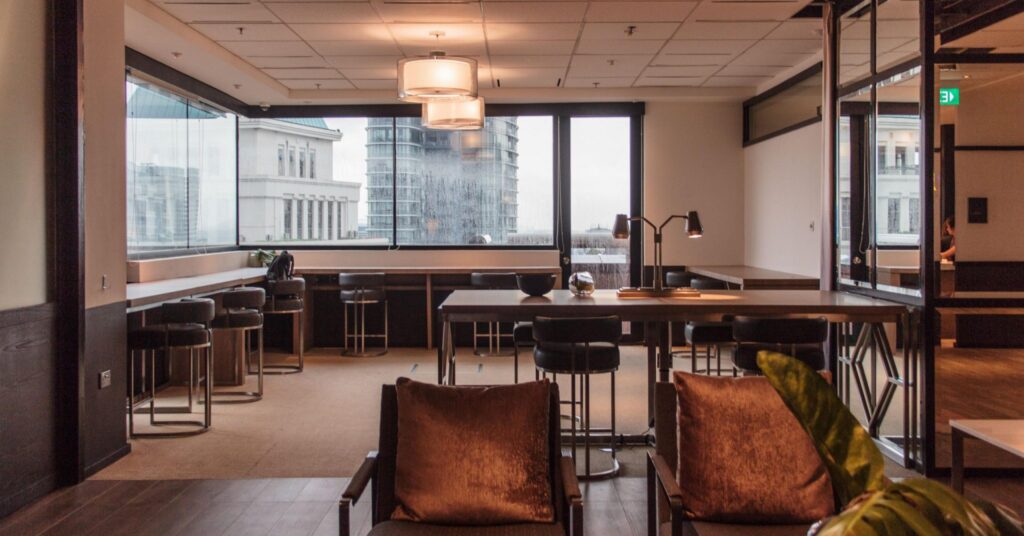“Traditional” long-term offices can be the best choice for many businesses. At the same time, flexible space options are becoming more popular, with shorter leases that allow businesses to take more or less space as they scale up or down. There are a variety of flexible space types — coworking spaces, serviced offices and surplus spaces – that appeal to different business needs. Nonetheless, many still assume that flexible spaces are reserved for smaller, less established companies.
Reasons for choosing coworking
“Coworking”, in particular, is a word often associated with the small startup or the edgy entrepreneur. While not entirely untrue, coworking spaces in Singapore are now appealing to companies of different sizes and stages of growth. We’ve seen small and medium-sized enterprises with up to 100 headcount rent offices in coworking spaces. Why? Coworking offices can be both cost-effective and flexible enough to accommodate different business needs.
In this coworking space case study, we share the journey of Mayer & Chan, a boutique financial consultancy in Singapore. Mayer & Chan’s beautiful office for 20 people is located in the CBD and the end of their three-year lease is coming up soon. Renewing the lease may come with a significant rental increase, so Mayer & Chan decided to consider all their options for a similar-sized office and explore other long-term offices. Through Mayer & Chan’s journey, we hope you can get a better understanding of how small and medium-sized businesses can transition from a long-term office to a coworking space.
Choosing a new office space
For the past eighteen years, Mayer & Chan have operated from offices in the CBD. Due to the nature of their business, they needed to be close to their clients, who are also located in the CBD. While their current office meets their location criteria, the new rental costs will likely be too high. With the company’s three-year lease set to expire in six months, it was time to start shopping for new workspace options.
Mayer & Chan wanted to see if there were better options in the CBD, preferably nearby and at the same or better rate. As a company that meets clients often, they also wanted a space that was well-designed and looked professional.
Step 1: The search for office space begins
Apart from these broad criteria, Mayer & Chan didn’t have a specific type of workspace in mind and was open to a range of options. In this case, they turned to GorillaSpace to help refine their search. Using GorillaSearch, Mayer & Chan submitted a request detailing their criteria. They indicated that they wanted to be in the CBD, specifically in close proximity to Raffles Place or City Hall. These locations would make their office easily accessible for clients as well as employees. Additionally, this area is home to many food options and bars – perfect for entertaining clients.
From their GorillaMatch request, Mayer & Chan received direct offers from a variety of workspaces. These included a few office suites in coworking spaces, serviced offices that offered the privacy and luxury of a beautiful reception area, and an under-utilized office space from one corporate business, as well as one long-term space that matched their budget. Mayer & Chan browsed through photos of each verified space and contacted the space operators directly.
Step 2: Narrowing it down coworking options
Next, Mayer & Chan narrowed down their shortlist to three coworking spaces and one surplus space that checked all their boxes. Since the company fully depreciated the fit-out of their previous location, they were free to switch to a new space without incurring an extra cost on their balance sheet. Moving to a flexible space made sense for Mayer & Chan in the foreseeable future.
On average, the shortlisted options were significantly more affordable than leasing another long-term space. Let’s break down the costs for a 24-month lease term. In terms of rent, Mayer & Chan would be paying at most $20,000 per month at a premium coworking suite for 20 people. If they signed a new long term lease, they could be charged $9 per square foot for premium space. With an office spanning 2,000 square feet, this rental rate translated to a rental of $18,000 per month, which is less than the price they would pay at a premium coworking space — or is it?
Mayer & Chan would also need to factor-in additional costs that come with a long-term lease. As a bare-shell unit, the upfront costs of fitting-out the space would amounted to $200,000 for a premium fitout. In addition, Mayer & Chan would also have to pay for running costs, which include utilities, electricity, water, and taxes. At the coworking options, the spaces are already fitted out and include running costs. No matter which scenario, Mayer & Chan would need to spend around $30,000 on reinstating their old unit before moving out. Factoring in the fitout and running costs of a new long-term lease, renting a coworking space was at least 23% less costly — and came with more options for meeting rooms!
Similarly, with a corporate surplus space option, Mayer & Chan would pay less than before for their own space at a prestigious business address. The only downside to the surplus space option would be that after 14 months, they would need to search for a new lease or re-negotiate new terms. Coworking spaces ultimately involved more flexibility and less paperwork.
All coworking spaces were ready for move-in, including shared amenities like meeting rooms and boardrooms. Of the four shortlisted spaces, all were within or around the CBD area and within walking distance of MRT stations. The final decision came down to how well the options fitted their business needs for the foreseeable 24 months.
Step 3: The Visiting Process
Mayer & Chan visited all three coworking spaces in their final shortlist. All options seemed viable on paper, and now, they needed to physically test each space to find the best one for their business. In addition, they were unsure of what it was really like to work in a shared space. As a client-facing company, the number one factor they looked out for was the quality of meeting rooms. Other aspects to consider included design of the space, comfort of chairs and tables, amount of natural lighting, availability of phone booths, and the speed of WiFi connection.
Mayer & Chan were assured by the all three coworking operators about privacy. For one of the spaces, the sales manager even walked them through an app for booking on-demand meeting rooms. The company ultimately managed to negotiate a private office overlooking a stunning view of downtown Singapore.
The final verdict was a luxury coworking space in Orchard well-known for its high-end interiors and sleek, professional design. Meeting rooms were spacious, easy to book, and enabled different setups. Conference rooms were available for formal discussions with clients, and cluster setups were possible for internal brainstorming sessions. The space was well-lit, tech-savvy, and included community members who were also in the finance or consulting sectors. Even though the space might be considered luxury for a coworking space, it was still far more affordable than another long-term office lease.
Step 4: Finalizing the Coworking Lease Terms
Within this coworking space, Mayer & Chan opted for a private office for 30 people with a stepped rent. Since the company had no plans of moving out within the next couple of years, they signed a two-year lease, including the option to increase or decrease headcount with no extra penalties and a two-month rent-free period. This rent-free period allowed Mayer & Chan to move into the new space without paying double-rent.
The move went smoothly for Mayer & Chan. Within just a few days, the team set up shop in their new space within a vibrant community of professionals. To ensure that their business still had a brand presence, Mayer & Chan put up their logo on their new office door as the finishing touch.
Final Thoughts
This case study is a light account of a small business looking for office space, and the journey of transitioning from a “traditional office” to a coworking space. In Singapore, there are coworking spaces with private offices that can accommodate a headcount of 10 to 20 to even 100 persons! For “grown up startups” or medium-sized businesses, a coworking space can offer both convenience and community benefits. Moving out from a long-term space to a flexible option is not a “downgrade” by any means. Want to learn more about coworking spaces? Check out our guide to coworking for more information.
Ultimately, whatever workspace you choose, it’s important that you know what you want as a business. If you don’t have a specific idea in mind, consider going flexible! As the name suggests, you have the flexibility to try a coworking space out before committing over the long haul. At GorillaSpace, you can browse through the largest collection of coworking spaces on the market. Each has a different vibe and characteristics that appeal to a variety of businesses, from creative agencies to suit-and-tie consultancies like Mayer & Chan.
Check out 360º panoramas and HD photos of workspaces on GorillaSpace. If you have more specific requests, just let us know through GorillaSearch and in no time our smart engine will curate the spaces that best match your needs.
Originally published – read original publication
Originally published by Gabrielle Ibasco / Posted on 28 Aug 2021.

In gorillaspace


